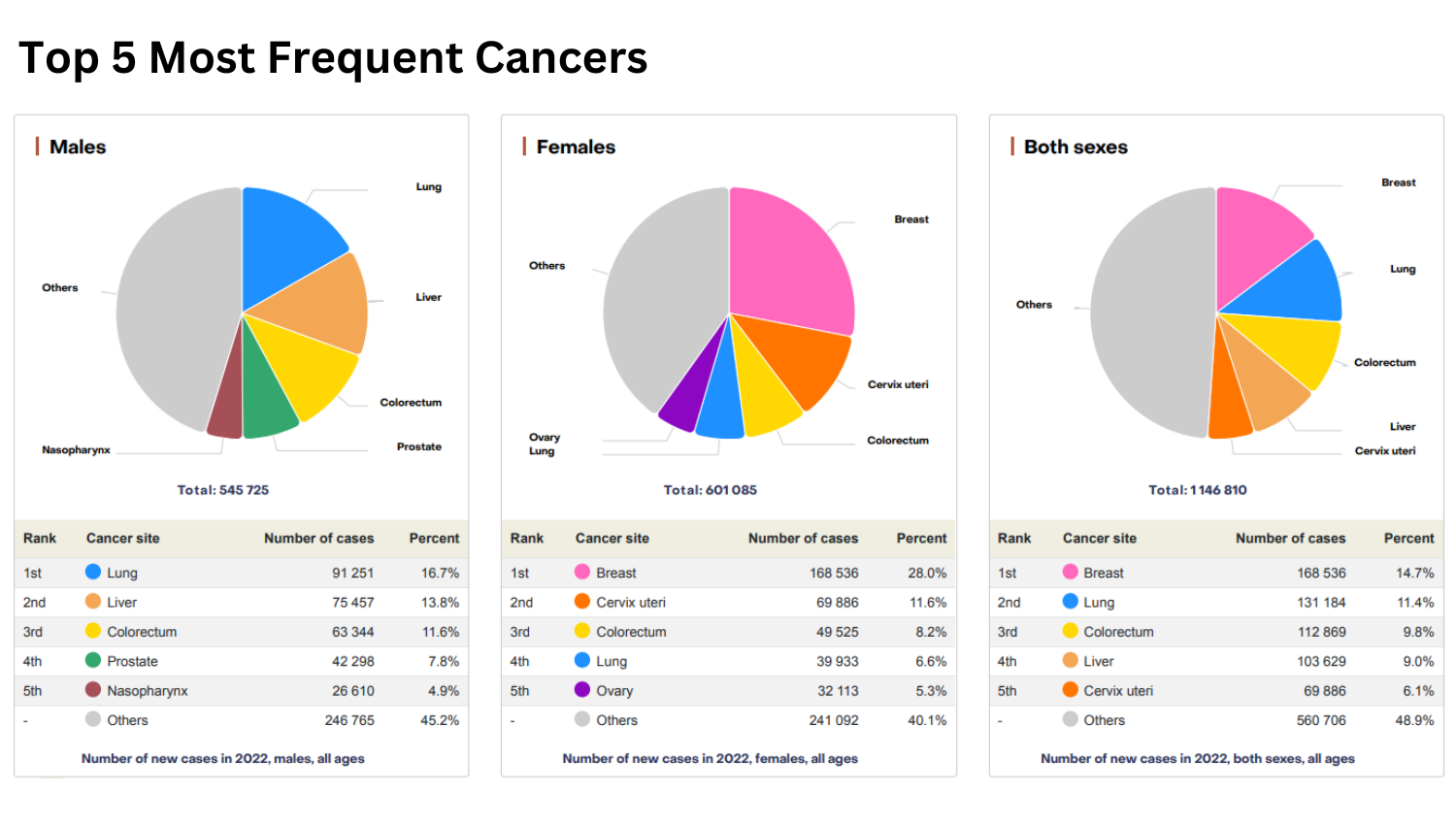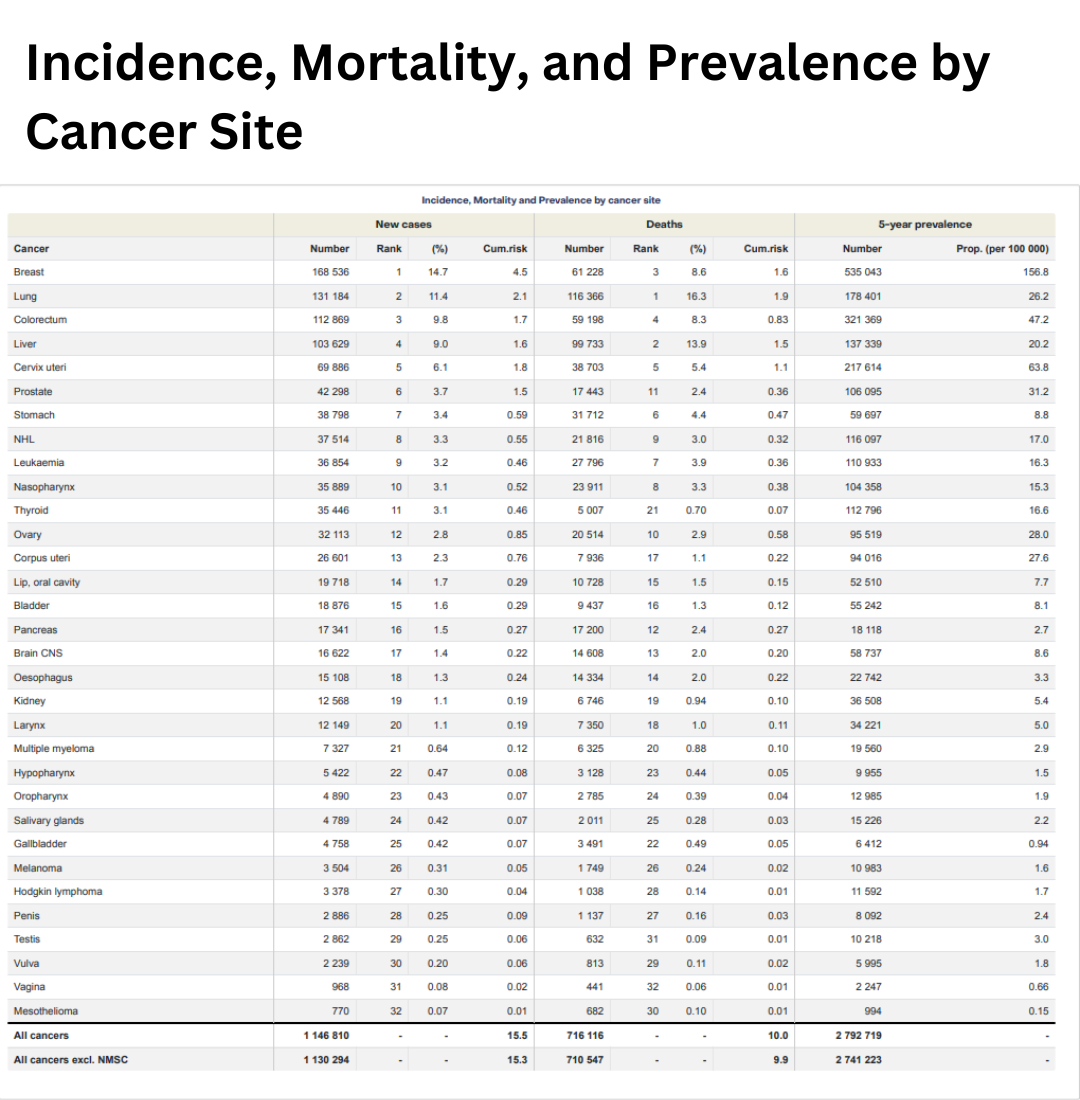东南亚国家的癌症统计数据:性别、类型及其他
Cancer is one of the most pressing public health challenges globally, and Southeast Asia faces its fair share of this burden. At MYmAb Biologics, we are dedicated to advancing global cancer research by providing high-quality Southeast Asian (SEA) human tissue microarrays (TMAs). This mission reflects our deep commitment to supporting the fight against cancer.
In our last post, we have shared the Cancer Statistics in South, East & South-Eastern Asian Countries.
To also shed light on the impact of cancer within Southeast Asia, we’ve compiled data from the International Agency for Research on Cancer (IARC), a part of the World Health Organization (WHO).
The 2022 findings paint a stark picture of the cancer burden in this region. Join us as we dive into key statistics, breaking them down by gender, cancer types, and their effects on the population.
Overview of Southeast Asian Cancer Statistics
In Southeast Asia, the total number of new cancer cases in 2022 reached a staggering 1,146,810 with 716,116 deaths attributed to the disease. These numbers highlight the urgent need for enhanced awareness, early detection, and treatment programs to combat the rising cancer burden effectively.
Cancer Statistics by Gender in the SEA Region
Source: The Global Cancer Observatory | Globocan 2022 (version 1.1) – 08.02.2024
Male Population
Population: 340,253,165
Number of New Cancer Cases: 545,725
Leading Cancer Types (by New Cases):
1. Lung Cancer
2. Liver Cancer
3. Colorectum Cancer
Number of Cancer Deaths: 385,430
Leading Cancer Types (by Deaths):
1. Lung Cancer
2. Liver Cancer
3. Colorectum Cancer
Lung cancer emerges as the most common cancer among men, both in terms of incidence and mortality. Its high fatality rate underscores the critical need for targeted prevention strategies, including reducing tobacco use.
Female Population
Population: 341,238,367
Number of New Cancer Cases: 601,085
Leading Cancer Types (by New Cases):
1. Breast Cancer
2. Cervix Uteri Cancer
3. Colorectum Cancer
Number of Cancer Deaths: 330,686
Leading Cancer Types (by Deaths):
1. Breast Cancer
2. Cervix Uteri Cancer
3. Lung Cancer
Breast cancer is the most diagnosed cancer among women, yet lung cancer causes the highest number of deaths. This suggests disparities in early detection and treatment access, particularly for lung and cervical cancers.
Cancer Statistics by Types of Cancer in SEA Regions
乳腺癌
Breast cancer ranks first among all cancer types in SEA regions when categorized by new cases, with 168,536 new reported cases in 2022. However, it ranks third in cancer-related deaths, with 61,228 deaths. These figures suggest progress in treatment and survival rates compared to other cancers.
Lung Cancer
A new lung cancer cases of 131,184 is reported in 2022. Lung cancer tops the chart when it comes to mortality. It is the leading cause of cancer deaths, first among men and the third among women. Preventative measures, such as anti-smoking campaigns, can significantly reduce its impact.
Colorectum Cancer
A new lung cancer cases of 131,184 is reported in 2022. Lung cancer tops the chart when it comes to mortality. It is the leading cause of cancer deaths, first among men and the third among women. Preventative measures, such as anti-smoking campaigns, can significantly reduce its impact.
Source: The Global Cancer Observatory | Globocan 2022 (version 1.1) – 08.02.2024
MYmAb Biologics: Advancing Cancer Research in Southeast Asia
At MYmAb Biologics, we are a life science company specializing in Tissue Microarray (TMA) and digital pathology services, aiming to advance cancer research specifically targeted toward Southeast Asian populations. By providing human tumor TMAs sourced from the region, MYmAb Biologics enables global researchers to study cancer trends and develop region-specific treatments.
Some of the tumor TMAs offered by MYmAb Biologics include:
Breast Tumor Tissue Microarray (129 cases) – MBB1
- MBB1: 129 cases/132 cores: Breast tumor tissue array, including TNM and pathology diagnosis.
- MBB1a: 129 cases/132 cores: Breast tumor tissue array, including TNM, pathology diagnosis, and IHC markers.
View Breast Tumor Tissue Microarray (129 cases) – MBB1 here.
Colorectal Tumor Tissue Microarray (29 cases) - MC001
- MC001: 29 cases/60 cores, including TNM and pathology diagnosis.
View Colorectal Tumor Tissue Microarray (29 cases) – MC001 here.
Through these comprehensive tumor TMAs, MYmAb Biologics provides invaluable tools for studying breast, colorectal, and other cancers prevalent in Southeast Asia, facilitating advancements in personalized medicine and treatment efficacy.
How Tissue Microarray Technology Support Cancer Research/Oncology Research?
Tissue Microarray (TMA) technology allows researchers to analyze multiple tissue samples on a single slide. Tissue cores are extracted from donor blocks and arranged systematically into a single recipient block according to a predetermined layout. Each TMA can include tumor and normal tissues, representing various tissue types or different stages of a single tumor type.
The recipient block is sectioned and fixed onto glass slides for simultaneous analysis. This approach preserves valuable archived human tissue samples while minimizing their use. Additionally, TMA technology supports molecular profiling at the DNA, RNA, and protein levels, providing comprehensive insights into cancer biology.
Key Benefits of TMAs
High-throughput analysis: Enables simultaneous analysis of multiple tissue samples, facilitating large-scale clinical studies efficiently
Consistency: Ensure all samples on a single TMA slide are analyzed under identical experimental conditions, enhancing the reliability and reproducibility of results.
Cost-effective: Concentrating multiple samples on a single slide, reduces labor costs for massive slides preparation and conserved reagents needed for analysis.
At MYmAb Biologics, all TMAs are IRB-approved and fully consented, sourced exclusively from Southeast Asia. These samples represent a diverse array of cancer types, including normal, cancerous, and tumor tissues from organs such as the breast, liver, and colorectal regions. By offering region-specific TMAs, MYmAb Biologics enables researchers to study the unique cancer patterns within Southeast Asia, fostering innovation in diagnostic and treatment strategies.
结论
The cancer statistics from Southeast Asia in 2022 present a mixed picture of progress and challenges. While strides have been made in combating certain cancers, others—notably lung and cervical cancers—still claim a significant number of lives.
Only by addressing these critical issues, can Southeast Asia make meaningful progress in the fight against cancer.
Fully understanding that, at MYmAb Biologics, we are dedicated to advancing life sciences through high-quality, ethically sourced tumor tissue microarrays (TMAs) tailored for global research needs. Specializing in Southeast Asian (SEA) samples, we provide researchers worldwide with IRB-approved and fully consented TMAs. Our collection spans diverse human tissues—such as breast, liver, and colorectal—covering normal, adjacent normal, and tumor samples to support comprehensive cancer studies. For more info about our tumor TMA slides, visit our product page or talk to our team now.




